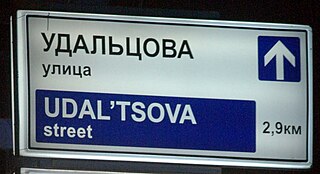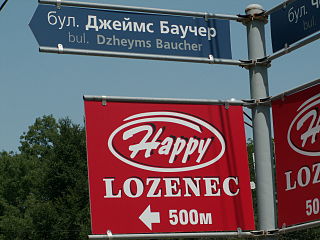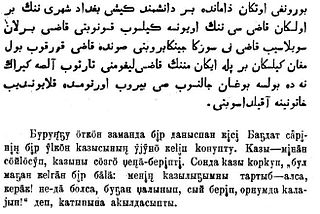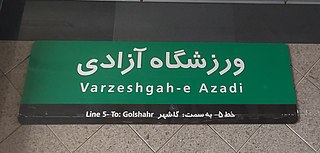Related Research Articles

Romanization or romanisation, in linguistics, is the conversion of text from a different writing system to the Roman (Latin) script, or a system for doing so. Methods of romanization include transliteration, for representing written text, and transcription, for representing the spoken word, and combinations of both. Transcription methods can be subdivided into phonemic transcription, which records the phonemes or units of semantic meaning in speech, and more strict phonetic transcription, which records speech sounds with precision.
Chechen is a Northeast Caucasian language spoken by approximately 1.5 million people, mostly in the Chechen Republic and by members of the Chechen diaspora throughout Russia and the rest of Europe, Jordan, Central Asia and Georgia.

The state anthem of the Republic of Tatarstan was composed by Tatar musician Röstäm Yaxin and was first adopted in 1993 without lyrics. Twenty years later, lyrics written by Ramazan Baytimerov were made official.

The romanization of the Russian language, aside from its primary use for including Russian names and words in text written in a Latin alphabet, is also essential for computer users to input Russian text who either do not have a keyboard or word processor set up for inputting Cyrillic, or else are not capable of typing rapidly using a native Russian keyboard layout (JCUKEN). In the latter case, they would type using a system of transliteration fitted for their keyboard layout, such as for English QWERTY keyboards, and then use an automated tool to convert the text into Cyrillic.
The romanization of Ukrainian, or Latinization of Ukrainian, is the representation of the Ukrainian language in Latin letters. Ukrainian is natively written in its own Ukrainian alphabet, which is based on the Cyrillic script. Romanization may be employed to represent Ukrainian text or pronunciation for non-Ukrainian readers, on computer systems that cannot reproduce Cyrillic characters, or for typists who are not familiar with the Ukrainian keyboard layout. Methods of romanization include transliteration and transcription.

Yi is a letter of the Cyrillic script. Yi is derived from the Greek letter iota with diaeresis.

Romanization of Bulgarian is the practice of transliteration of text in Bulgarian from its conventional Cyrillic orthography into the Latin alphabet. Romanization can be used for various purposes, such as rendering of proper names and place names in foreign-language contexts, or for informal writing of Bulgarian in environments where Cyrillic is not easily available. Official use of romanization by Bulgarian authorities is found, for instance, in identity documents and in road signage. Several different standards of transliteration exist, one of which was chosen and made mandatory for common use by the Bulgarian authorities in a law of 2009.

The romanization of Arabic is the systematic rendering of written and spoken Arabic in the Latin script. Romanized Arabic is used for various purposes, among them transcription of names and titles, cataloging Arabic language works, language education when used instead of or alongside the Arabic script, and representation of the language in scientific publications by linguists. These formal systems, which often make use of diacritics and non-standard Latin characters and are used in academic settings or for the benefit of non-speakers, contrast with informal means of written communication used by speakers such as the Latin-based Arabic chat alphabet.

The Ukrainian Latin alphabet is the form of the Latin script used for writing, transliteration and retransliteration of Ukrainian.
The Kyrgyz language is written in the Kyrgyz alphabet, a modification of Cyrillic. There is no commonly accepted system of romanization for Kyrgyz, i.e. a rendering of Kyrgyz in the Latin alphabet. For geographic names, the Kyrgyz government adopted the BGN/PCGN romanization system. There have been periodic discussions about changing the country's official writing system to Latin script. These proposals have seen little progress as the Cyrillic alphabet is more firmly established in Kyrgyzstan than in other post-Soviet Turkic states, which have either successfully switched to Latin script or are in active transition. Some Kyrgyz romanization systems are given below:
The romanization of Khmer is a representation of the Khmer (Cambodian) language using letters of the Latin alphabet. This is most commonly done with Khmer proper nouns, such as names of people and geographical names, as in a gazetteer.

Three alphabets are used to write the Kazakh language: the Cyrillic, Latin and Arabic scripts. The Cyrillic script is used in Kazakhstan and Mongolia. An October 2017 Presidential Decree in Kazakhstan ordered that the transition from Cyrillic to a Latin script be completed by 2025. The Arabic script is used in Arabia, Iran, Afghanistan and parts of China.
Scientific transliteration, variously called academic, linguistic, international, or scholarly transliteration, is an international system for transliteration of text from the Cyrillic script to the Latin script (romanization). This system is most often seen in linguistics publications on Slavic languages.
Romanization or Latinization of Belarusian is any system for transliterating written Belarusian from Cyrillic to the Latin alphabet.
BGN/PCGN romanization system for Russian is a method for romanization of Cyrillic Russian texts, that is, their transliteration into the Latin alphabet as used in the English language.
The romanization of Macedonian is the transliteration of text in Macedonian from the Macedonian Cyrillic alphabet into the Latin alphabet. Romanization can be used for various purposes, such as rendering of proper names in foreign contexts, or for informal writing of Macedonian in environments where Cyrillic is not easily available. Official use of romanization by North Macedonia's authorities is found, for instance, on road signage and in passports. Several different codified standards of transliteration currently exist and there is widespread variability in practice.
The BGN/PCGN romanization system for Belarusian is a method for romanization of Cyrillic Belarusian texts, that is, their transliteration into the Latin alphabet.

Romanization of Persian or Latinization of Persian is the representation of the Persian language with the Latin script. Several different romanization schemes exist, each with its own set of rules driven by its own set of ideological goals.
BGN/PCGN romanization system for Kazakh is a method for romanization of Cyrillic Kazakh texts, that is, their transliteration into the Latin alphabet as used in the English language.
BGN/PCGN romanization system for Kyrgyz is a method for romanization of Cyrillic Kyrgyz texts, that is, their transliteration into the Latin alphabet as used in the English language.
References
- ↑ "Romanization Systems and Policies". National Geospatial-Intelligence Agency. 14 May 2017. Retrieved 14 May 2017.
- ↑ US Board on Geographic Names (1994). Romanization Systems and Roman-Script Spelling Conventions (PDF). Defense Mapping Agency. OCLC 31881487 . Retrieved 8 January 2013.
- ↑ Romanization systems - GOV.UK Guidance on the US Board on Geographic Names (BGN)/Permanent Committee on Geographical Names (PCGN) romanization systems.
- ↑ Romanization system for Bulgarian: BGN/PCGN 2013 System. National Geospatial-Intelligence Agency, September 2014.